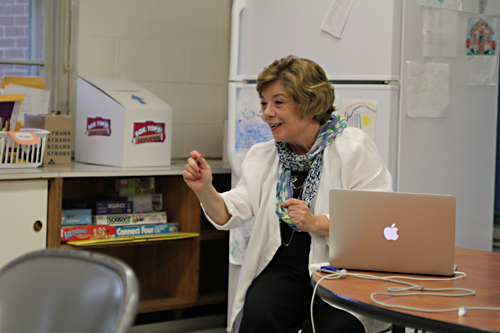Oysterponds aiming to build on combined-grades program

Oysterponds Elementary School officials are describing the district’s combined-grades program, introduced in the 2013-14 school year, as a resounding success — and they’re preparing to build upon the new academic structure for the next school year.
This school year, the pre-K through sixth-grade district in Orient combined eight grades into four levels: pre-K and kindergarten as “primary 1,” grades 1 and 2 as “primary 2,” grades 3 and 4 as “intermediate 1” and grades 5 and 6 as “intermediate 2.”
Each class has multiple teachers and assistants, including literacy, math and enrichment specialists, as well as a technology teacher assistant.
Superintendent Richard Malone first proposed the model last year to deal with the district’s dwindling enrollment and has said the structure provides enough support to give each student a “personal learning plan.”
During the school board’s Tuesday meeting, Mr. Malone said this year’s model was a success due to collaborative efforts by teachers.
“It’s been a lot of hard work,” he said. “There’s no question about it, but I think they’re feeling the rewards.”
Karen Lund, the school’s training/support specialist, gave a presentation about the district’s combined-grades program and shared feedback she’s received from students and teachers.
Children said they enjoyed reading circles, hands-on learning opportunities and working with classmates, she said.
One student remarked: “Combined classes was better than we expected. We had more friends and had more opportunities,” Ms. Lund said.
As for the new learning experiences, she said teachers are facilitating discussion as opposed to solely teaching content.
At the start of the school year, teachers asked their students an “essential question” that was repeated throughout the year and revisited this month, Ms. Lund said.
In primary 1, students were asked: “How do authors tell us their stories?” Primary 2 students were asked: “What is light?” In intermediate 1, students were asked: “Why was the Erie Canal so important for the economy of New York State?” And the intermediate 2 class was asked: “How can we convey information to others in an interesting way?”
“The essential questions are all open-ended,” Ms. Lund said. “That’s what sparks curiosity among children. Because the questions are open-ended, the teacher isn’t sitting there hoping for the correct answer. The teacher is standing there, or working with the kids, listening for all different kinds of answers and the children get very excited about their learning.”
School board member Jeff Demarest also praised the new model, which his sixth-grade daughter experienced this school year.
“She was not happy with the fact that it was going to be combined with the little kids,” he said, “but she ended the year really enjoying it and I didn’t think that was going to happen.”
[email protected] Follow @jengust








